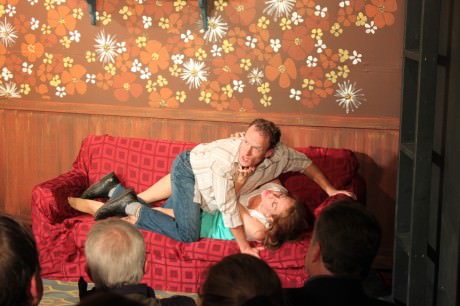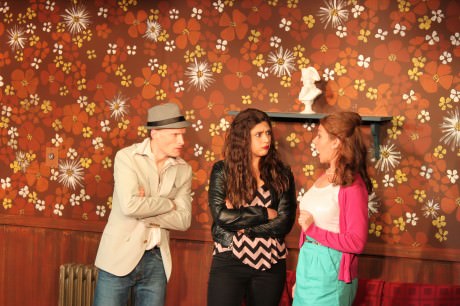Jean-Paul Sartre was not only a great playwright, but one of the leading philosophers of the 20th Century. He wrote No Exit during the German Occupation of France during WWII, after he had been imprisoned and released for ill health. It was also after he began to see his fellow Frenchmen, who were Jewish or in the Resistance, be rounded up – some never to return. Judging from the way he wrote the role of Cradeau, he felt a great deal of shame for not being a bigger and more visible force in fighting the Occupation. Sartre later became a strong leader against anti-Semitism, as well as an early leader of human rights, especially for the Algerians during their war for freedom against France.

The Highwood Theatre’s production of No Exit stays true to the script and Sartre’s philosophy. People are punished by going to this hell where there is no mirrors, windows, only constant artificial light and doors that don’t open. This hell has no sleep, eyes that never blink, and constant heat. The torturers in this hell are the other characters. Inez, who is a lesbian, wants Estelle, who wants Cradeau. Cradeau, who does feel attracted to Estelle, cannot consummate his relationship with Estelle because of Inez’s presence.
The cast performs as a wonderful ensemble. Tamara Breuer’s Inez is perfectly menacing and sadistic. She gives Inez the power that the character needs to seduce Estelle and control Cradeau when the seduction fails. Inez tells Estelle that she will be her mirror, but then becomes a mirror for them all; making the other two tell their dark histories after she tells her own.
Jennifer Berry’s Estelle is demure and evil. She allows her character to go from an incredulous “there must be a mistake” kindly persona to a murderer of her own child for convenience. She then plays the seductress to Cradeau with great skill.
Matthew Dundas, as Cradeau, is wonderful opening up to the others with revelations of his cowardice and exceptionally mean infidelity to his wife. However, I would have preferred him to be a little less angry and a little more wary at the beginning when he first enters with the Valet. A crescendo to anger and self-hate would have emphasized his duplicity and fear of internal ignominy. Dundas was at his best in the final scene when all the characters go into giddy hysteria.
The role of the Valet in this production is played by a woman, while in the original script it was a male role. Vivian Allvin play the Valet with humor, an element not found in the original script. This was a chancy decision by both the director and actress. However, it worked well within the framework of the play. It served as a wonderful contrast to the horrors we will witness later. Ms. Allvin has a wonderful stage presence and stole some scenes.
Ms. Alvin also performs some pre-curtain housekeeping chores and disco-type dancing. I found it took away from the playwright’s original intent.
Director Rachael Murray creates wonderful images, reminders of the direct translation of the title from the French – “In Camera.” I felt that these could be characters locked in this photograph of internal misery. Murray allows her actors to delve into the roles and this allows the audience a great insight – not only into their characters’ motivations – but into the thoughts of Sartre. The director did a great job of moving her actors in such a small space so they appeared natural. The action never drags. When at the end the famous line, “Hell is other people,” is said, it is not a cliché but a final and simple statement explaining what we have just witnessed.

I also want to applaud the interesting lighting effect at the opening of the show. It was perfectly eerie. A commendable job was done by the Set Designer and Painter James Raymond. The furniture was spot-on, and the door became more than scenery – but another character. I felt the costumes should have been from the era of the play, the 1940s. However, only one costume distracted from the performances. The mini-skirt worn by Estelle seemed to limit the actress’ movements and positions as well as being wrong for the time.
It’s so hard to produce a play that has become a modern classic, especially one that has a very serious theme, but Murray and her excellent cast do a fine job. The Highwood Theatre’s No Exiit is well worth seeing.
Running Time: One hour and forty minutes, with no intermission.
No Exit plays through November 9, 2014 at The Highwood Theatre – 914 Silver Spring Avenue, Suite 102, in Silver Spring, MD . For tickets call (301) 587-0697, or purchase them online.





